Abstract
This study reports that dexamethasone at a high dose (10(-4) mol/l) induced slowing of the in vitro proliferation of rabbit articular chondrocytes in both monolayer and clonal culture. This effect is consistent with an inhibition of DNA and RNA synthesis and was characterised by an accumulation of cells in the G0G1 phase of the cell cycle, as shown by flow cytometric analysis. Therefore we determined the extent of nuclear localisation of dexamethasone-receptor complexes. The results showed a discrepancy between 50% growth inhibitory dose (10(-4) mol/l) and the apparent affinity, KD (1.4 (SD 0.2) X 10(-9) mol/l). Thus the growth inhibition of rabbit articular chondrocytes by dexamethasone did not seem to be related exclusively to an interaction with the glucocorticoid-receptor complexes.
Full text
PDF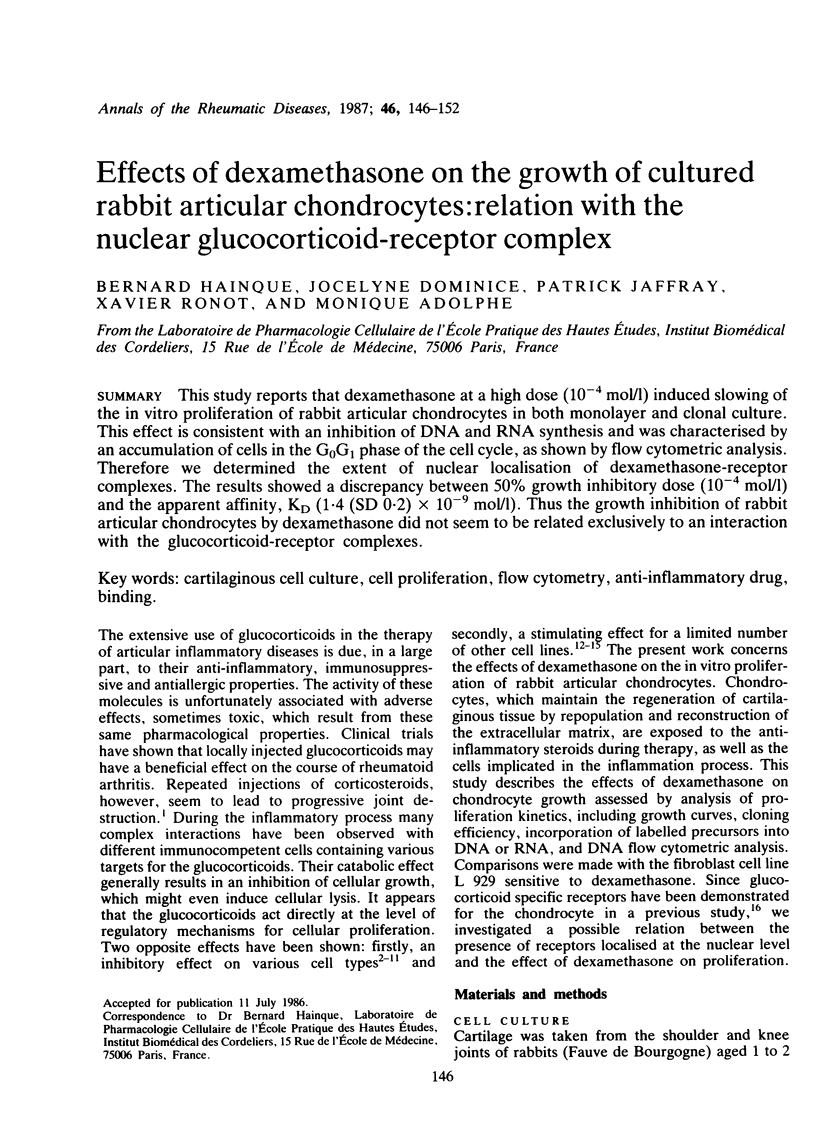
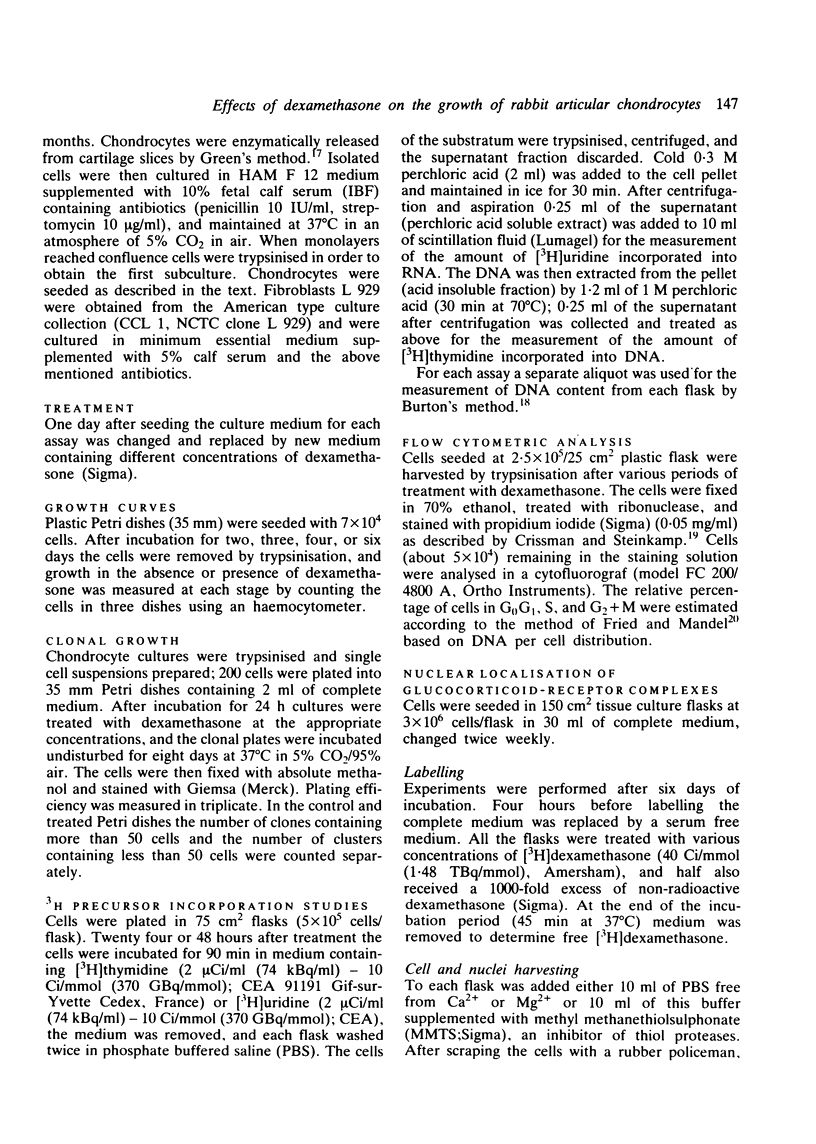
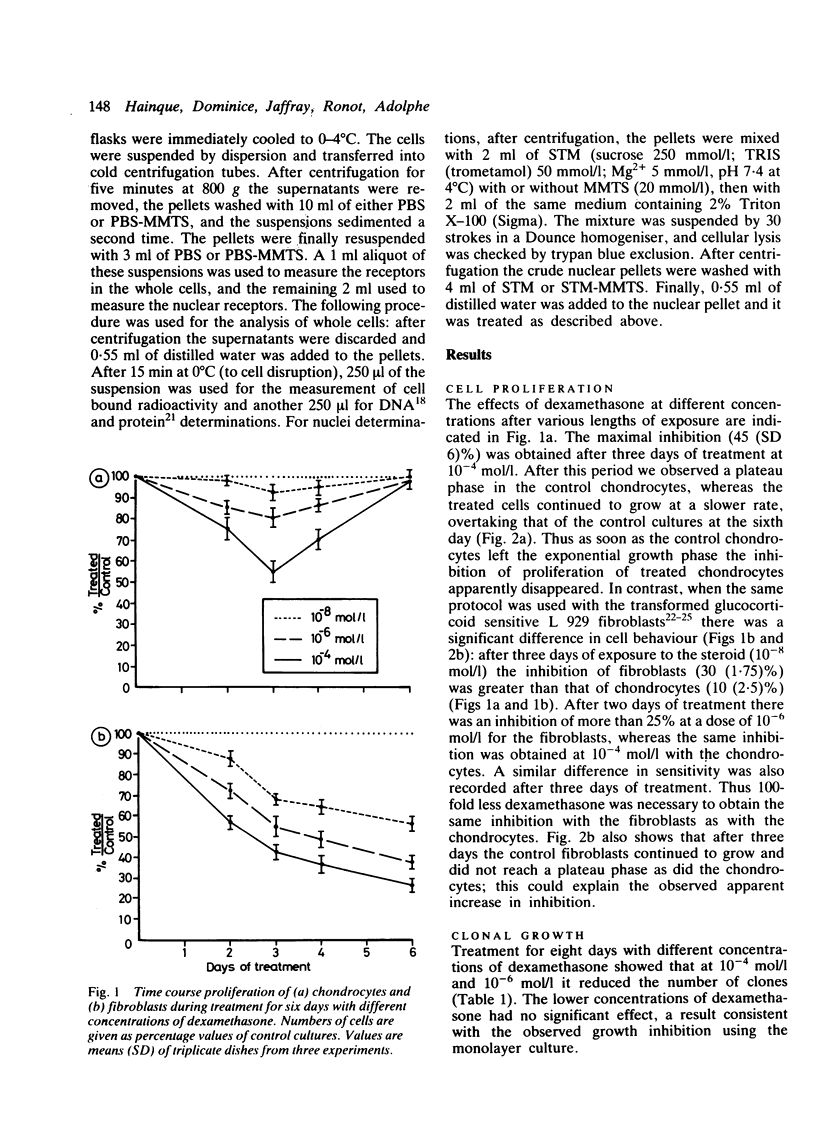
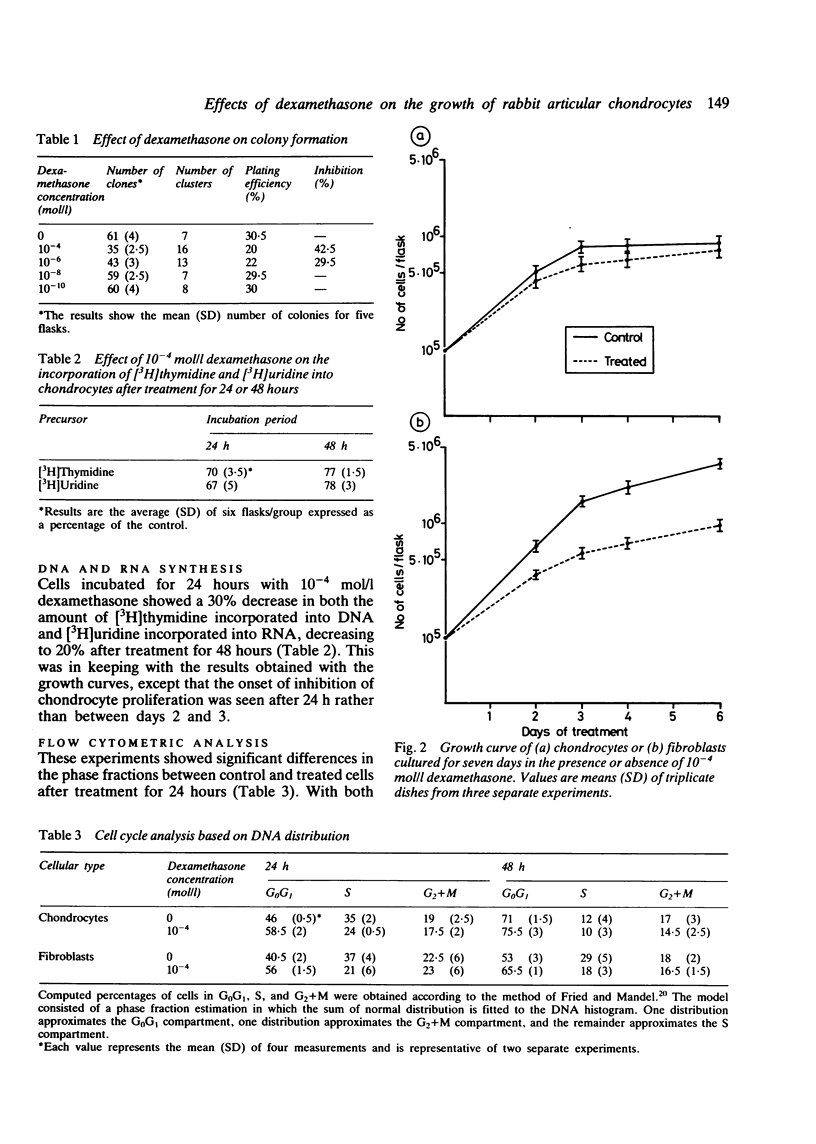
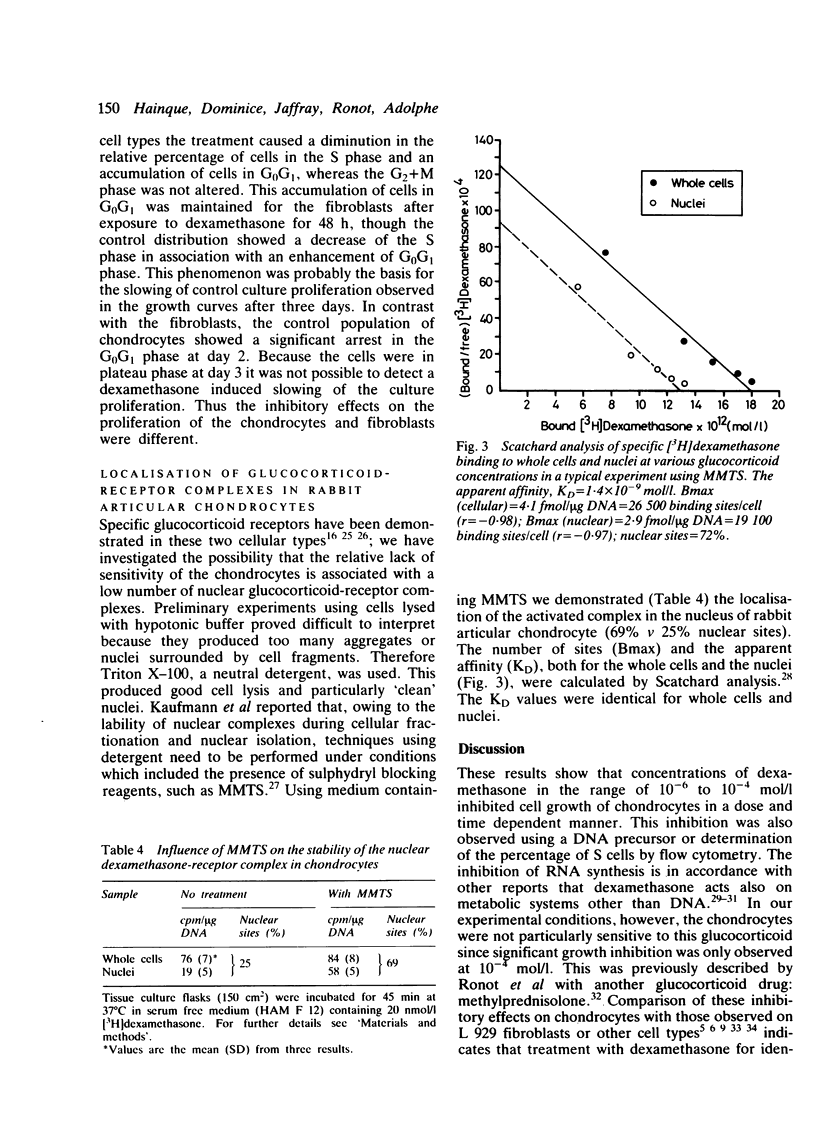
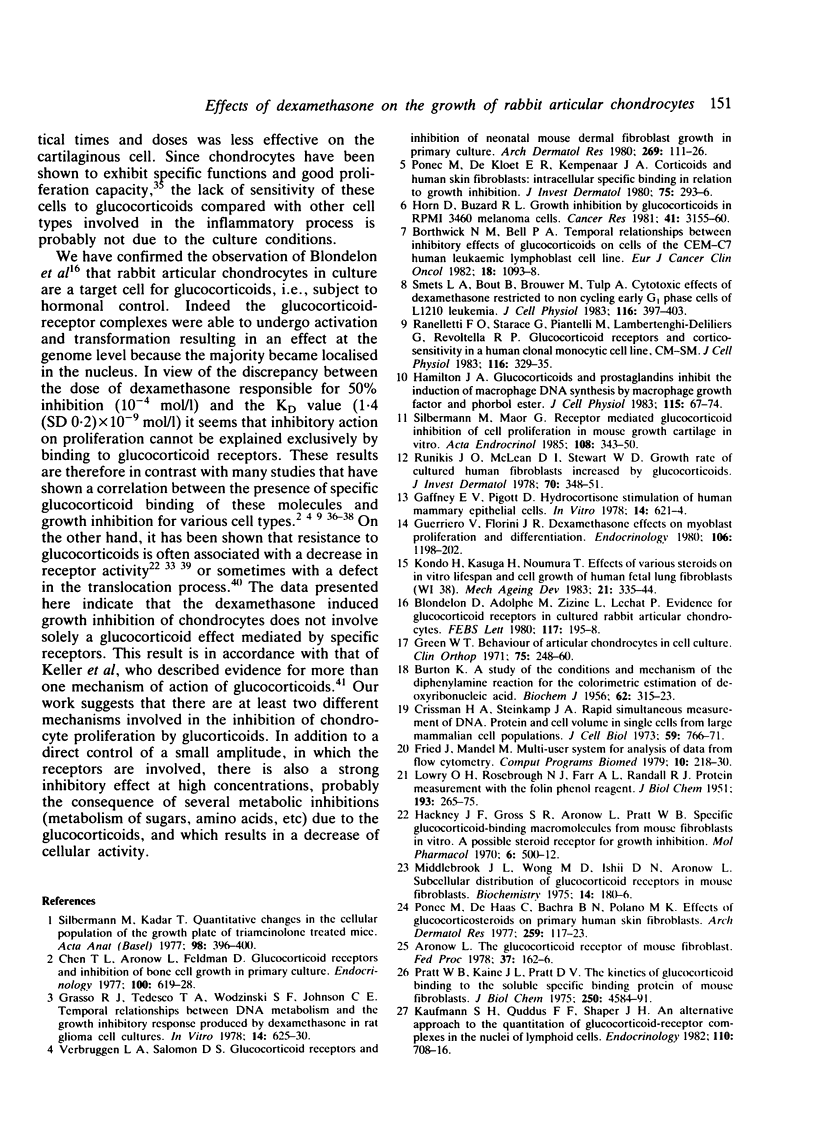
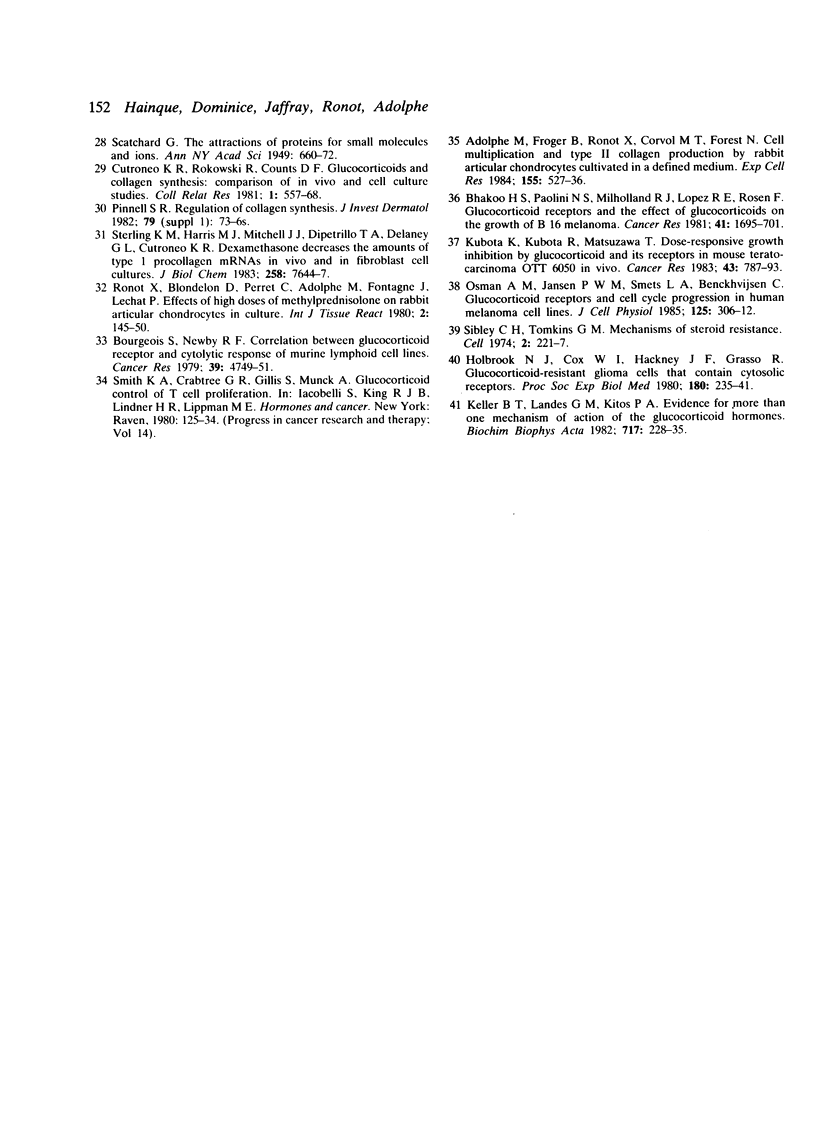
Selected References
These references are in PubMed. This may not be the complete list of references from this article.
- Adolphe M., Froger B., Ronot X., Corvol M. T., Forest N. Cell multiplication and type II collagen production by rabbit articular chondrocytes cultivated in a defined medium. Exp Cell Res. 1984 Dec;155(2):527–536. doi: 10.1016/0014-4827(84)90212-x. [DOI] [PubMed] [Google Scholar]
- Aronow L. The glucocorticoid receptor of mouse fibroblasts. Fed Proc. 1978 Feb;37(2):162–166. [PubMed] [Google Scholar]
- BURTON K. A study of the conditions and mechanism of the diphenylamine reaction for the colorimetric estimation of deoxyribonucleic acid. Biochem J. 1956 Feb;62(2):315–323. doi: 10.1042/bj0620315. [DOI] [PMC free article] [PubMed] [Google Scholar]
- Bhakoo H. S., Paolini N. S., Milholland R. J., Lopez R. E., Rosen F. Glucocorticoid receptors and the effect of glucocorticoids on the growth of B16 melanoma. Cancer Res. 1981 May;41(5):1695–1701. [PubMed] [Google Scholar]
- Blondelon D., Adolphe M., Zizine L., Lechat P. Evidence for glucocorticoid receptors in cultured rabbit articular chondrocytes. FEBS Lett. 1980 Aug 11;117(1):195–199. doi: 10.1016/0014-5793(80)80943-4. [DOI] [PubMed] [Google Scholar]
- Borthwick N. M., Bell P. A. Temporal relationships between inhibitory effects of glucocorticoids on cells of the CEM-C7 human leukaemic lymphoblast cell line. Eur J Cancer Clin Oncol. 1982 Nov;18(11):1093–1098. doi: 10.1016/0277-5379(82)90089-x. [DOI] [PubMed] [Google Scholar]
- Bourgeois S., Newby R. F. Correlation between glucocorticoid receptor and cytolytic response of murine lymphoid cell lines. Cancer Res. 1979 Nov;39(11):4749–4751. [PubMed] [Google Scholar]
- Chen T. L., Aronow L., Feldman D. Glucocorticoid receptors and inhibition of bone cell growth in primary culture. Endocrinology. 1977 Mar;100(3):619–628. doi: 10.1210/endo-100-3-619. [DOI] [PubMed] [Google Scholar]
- Crissman H. A., Steinkamp J. A. Rapid, simultaneous measurement of DNA, protein, and cell volume in single cells from large mammalian cell populations. J Cell Biol. 1973 Dec;59(3):766–771. doi: 10.1083/jcb.59.3.766. [DOI] [PMC free article] [PubMed] [Google Scholar]
- Cutroneo K. R., Rokowski R., Counts D. F. Glucocorticoids and collagen synthesis: comparison of in vivo and cell culture studies. Coll Relat Res. 1981 Nov;1(6):557–568. doi: 10.1016/s0174-173x(81)80037-4. [DOI] [PubMed] [Google Scholar]
- Gaffney E. V., Pigott D. Hydrocortisone stimulation of human mammary epithelial cells. In Vitro. 1978 Jul;14(7):621–624. doi: 10.1007/BF02617922. [DOI] [PubMed] [Google Scholar]
- Grasso R. J., Tedesco T. A., Wodzinski S. F., Johnson C. E. Temporal relationships between DNA metabolism and the growth-inhibitory response produced by dexamethasone in rat glioma cell cultures. In Vitro. 1978 Jul;14(7):625–630. doi: 10.1007/BF02617923. [DOI] [PubMed] [Google Scholar]
- Green W. T., Jr Behavior of articular chondrocytes in cell culture. Clin Orthop Relat Res. 1971 Mar-Apr;75:248–260. doi: 10.1097/00003086-197103000-00030. [DOI] [PubMed] [Google Scholar]
- Hackney J. F., Gross S. R., Aronow L., Pratt W. B. Specific glucocorticoid-binding macromolecules from mouse fibroblasts growing in vitro. A possible steroid receptor for growth inhibition. Mol Pharmacol. 1970 Sep;6(5):500–512. [PubMed] [Google Scholar]
- Hamilton J. A. Glucocorticoids and prostaglandins inhibit the induction of macrophage DNA synthesis by macrophage growth factor and phorbol ester. J Cell Physiol. 1983 Apr;115(1):67–74. doi: 10.1002/jcp.1041150111. [DOI] [PubMed] [Google Scholar]
- Holbrook N. J., Cox W. I., Hackney J. F., Grasso R. J. Glucocorticoid-resistant glioma cells that contain cytosolic receptors. Proc Soc Exp Biol Med. 1980 Jul;164(3):235–241. doi: 10.3181/00379727-164-40854. [DOI] [PubMed] [Google Scholar]
- Horn D., Buzard R. L. Growth inhibition by glucocorticoids in RPMI 3460 melanoma cells. Cancer Res. 1981 Aug;41(8):3155–3160. [PubMed] [Google Scholar]
- Kaufmann S. H., Quddus F. F., Shaper J. H. An alternative approach to the quantitation of glucocorticoid-receptor complexes in the nuclei of lymphoid cells. Endocrinology. 1982 Mar;110(3):708–716. doi: 10.1210/endo-110-3-708. [DOI] [PubMed] [Google Scholar]
- Keller B. T., Landes G. M., Kitos P. A. Evidence for more than one mechanism of action of the glucocorticoid hormones. Biochim Biophys Acta. 1982 Aug 6;717(2):228–235. doi: 10.1016/0304-4165(82)90174-x. [DOI] [PubMed] [Google Scholar]
- Kondo H., Kasuga H., Noumura T. Effects of various steroids on in vitro lifespan and cell growth of human fetal lung fibroblasts (WI-38). Mech Ageing Dev. 1983 Mar-Apr;21(3-4):335–344. doi: 10.1016/0047-6374(83)90050-7. [DOI] [PubMed] [Google Scholar]
- Kubota K., Kubota R., Matsuzawa T. Dose-responsive growth inhibition by glucocorticoid and its receptors in mouse teratocarcinoma OTT6050 in vivo. Cancer Res. 1983 Feb;43(2):787–793. [PubMed] [Google Scholar]
- LOWRY O. H., ROSEBROUGH N. J., FARR A. L., RANDALL R. J. Protein measurement with the Folin phenol reagent. J Biol Chem. 1951 Nov;193(1):265–275. [PubMed] [Google Scholar]
- Osman A. M., Jansen P. W., Smets L. A., Benckhuijsen C. Glucocorticoid receptors and cell cycle progression in human melanoma cell lines. J Cell Physiol. 1985 Nov;125(2):306–312. doi: 10.1002/jcp.1041250220. [DOI] [PubMed] [Google Scholar]
- Ponec M., De Kloet E. R., Kempenaar J. A. Corticoids and human skin fibroblasts: intracellular specific binding in relation to growth inhibition. J Invest Dermatol. 1980 Oct;75(4):293–296. doi: 10.1111/1523-1747.ep12530810. [DOI] [PubMed] [Google Scholar]
- Ponec M., de Haas C., Bachra B. N., Polano M. K. Effects of glucocorticosteroids on primary human skin fibroblasts. I. Inhibition of the proliferation of cultured primary human skin and mouse L929 fibroblasts. Arch Dermatol Res. 1977 Aug 22;259(2):117–123. doi: 10.1007/BF00557951. [DOI] [PubMed] [Google Scholar]
- Pratt W. B., Kaine J. L., Pratt D. V. The kinetics of glucocorticoid binding to the soluble specific binding protein of mouse fibroblasts. J Biol Chem. 1975 Jun 25;250(12):4584–4591. [PubMed] [Google Scholar]
- Ranelletti F. O., Starace G., Piantelli M., Lambertenghi-Deliliers G., Revoltella R. P. Glucocorticoid receptors and cortico-sensitivity in a human clonal monocytic cell line, CM-SM. J Cell Physiol. 1983 Sep;116(3):329–335. doi: 10.1002/jcp.1041160310. [DOI] [PubMed] [Google Scholar]
- Runikis J. O., McLean D. I., Stewart W. D. Growth rate of cultured human fibroblasts increased by glucocorticoids. J Invest Dermatol. 1978 Jun;70(6):348–351. doi: 10.1111/1523-1747.ep12543546. [DOI] [PubMed] [Google Scholar]
- Sibley C. H., Tomkins G. M. Mechanisms of steroid resistance. Cell. 1974 Aug;2(4):221–227. doi: 10.1016/0092-8674(74)90014-2. [DOI] [PubMed] [Google Scholar]
- Silbermann M., Kadar T. Quantitative changes in the cellular population of the growth plate of triamcinolone-treated mice. Acta Anat (Basel) 1977;98(4):396–400. doi: 10.1159/000144818. [DOI] [PubMed] [Google Scholar]
- Silbermann M., Maor G. Receptor-mediated glucocorticoid inhibition of cell proliferation in mouse growth cartilage in vitro. Acta Endocrinol (Copenh) 1985 Mar;108(3):343–350. doi: 10.1530/acta.0.1080343. [DOI] [PubMed] [Google Scholar]
- Smets L. A., Bout B., Brouwer M., Tulp A. Cytotoxic effects of dexamethasone restricted to noncycling, early G1-phase cells of L1210 leukemia. J Cell Physiol. 1983 Sep;116(3):397–403. doi: 10.1002/jcp.1041160318. [DOI] [PubMed] [Google Scholar]
- Sterling K. M., Jr, Harris M. J., Mitchell J. J., DiPetrillo T. A., Delaney G. L., Cutroneo K. R. Dexamethasone decreases the amounts of type I procollagen mRNAs in vivo and in fibroblast cell cultures. J Biol Chem. 1983 Jun 25;258(12):7644–7647. [PubMed] [Google Scholar]
- Verbruggen L. A., Salomon D. S. Glucocorticoid receptors and inhibition of neonatal mouse dermal fibroblast growth in primary culture. Arch Dermatol Res. 1980;269(2):111–126. doi: 10.1007/BF00406531. [DOI] [PubMed] [Google Scholar]


